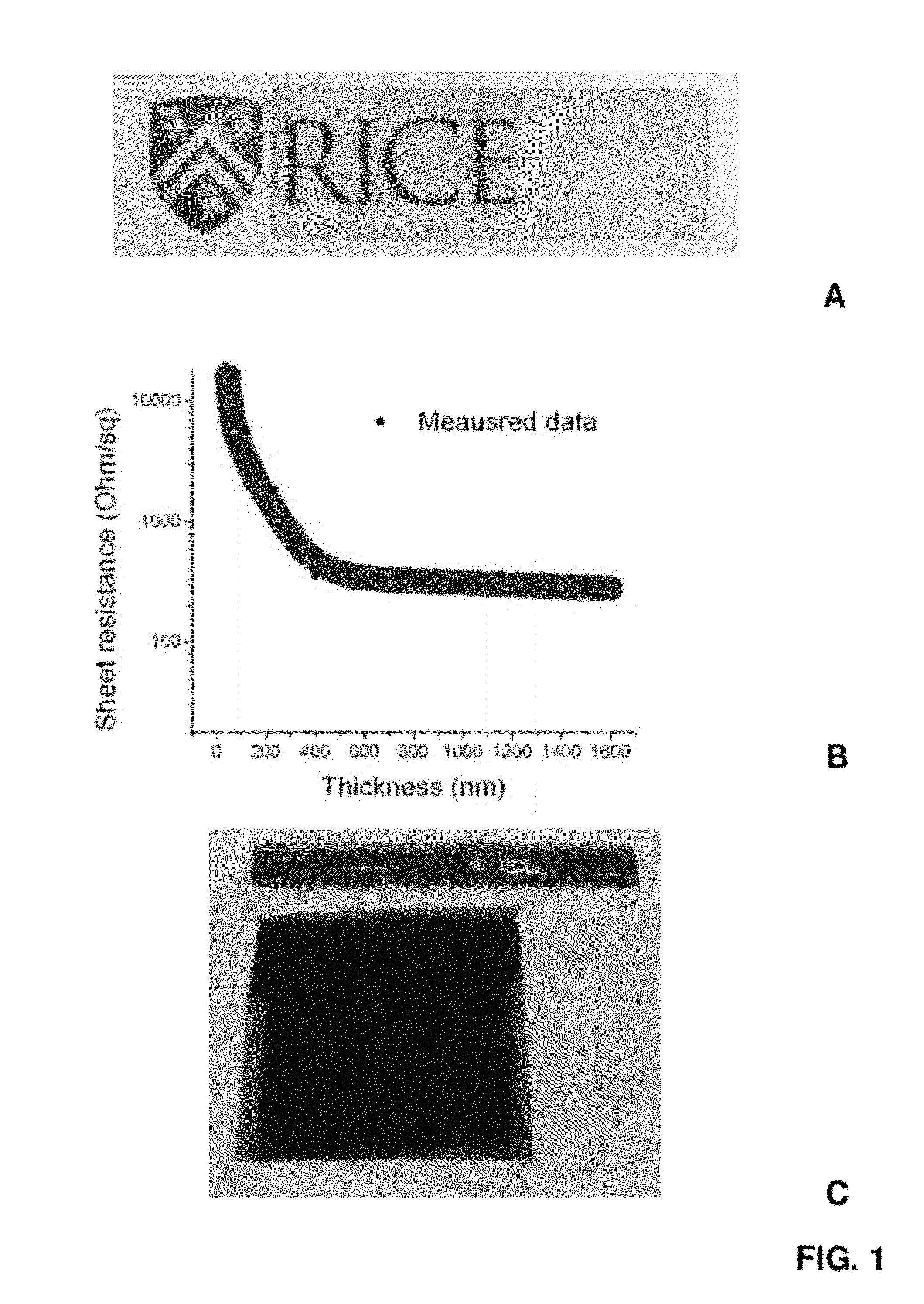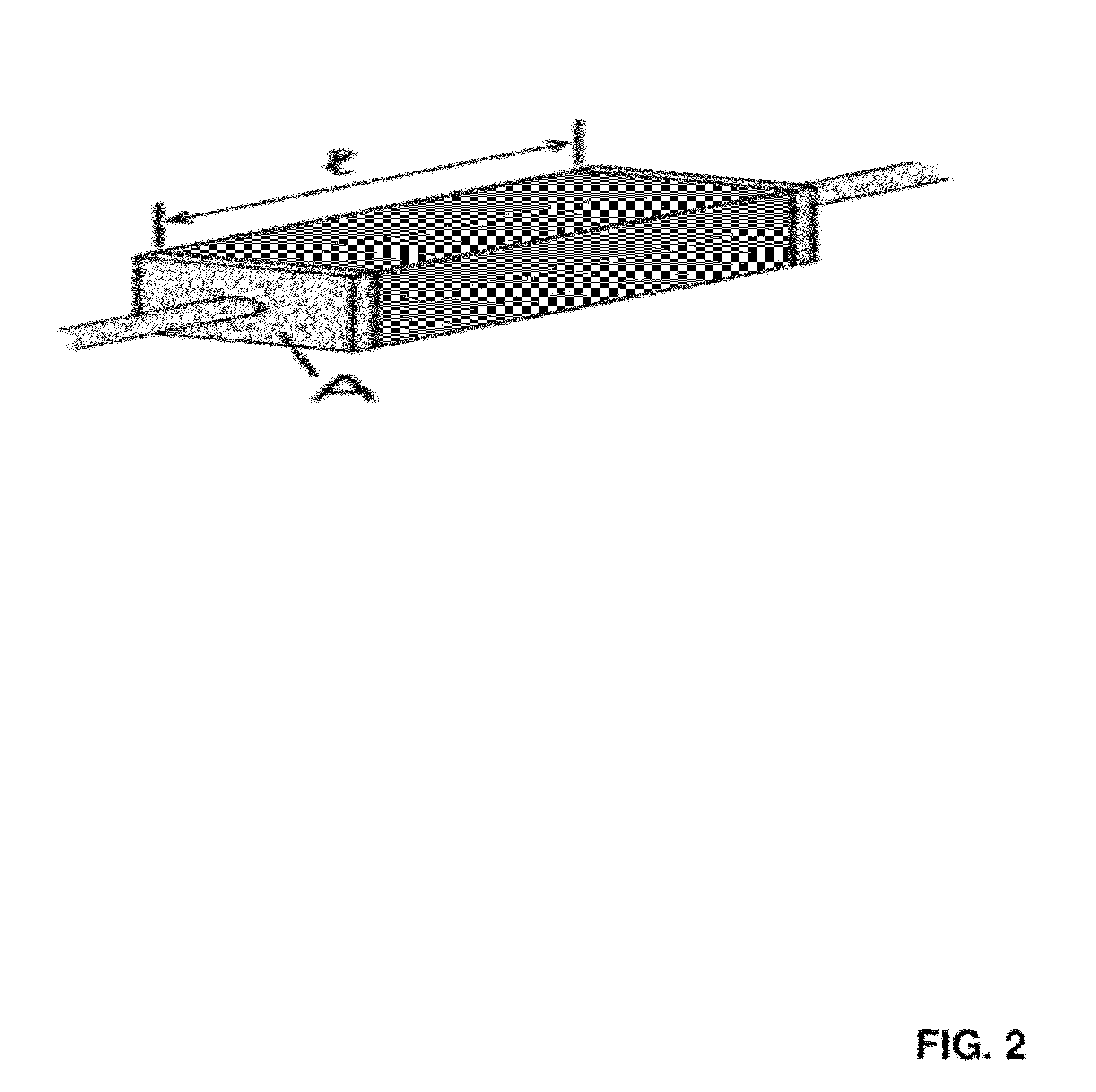Graphene-based thin films in heat circuits and methods of making the same
a graphene-based, heat-sealed film technology, applied in the direction of instruments, natural mineral layered products, synthetic resin layered products, etc., can solve the problems of limited radio frequency (rf) transparency, limited frequency operation band, numerous limitations of present-day heat-sealed circuits, etc., and achieve high conductive and low weight
- Summary
- Abstract
- Description
- Claims
- Application Information
AI Technical Summary
Benefits of technology
Problems solved by technology
Method used
Image
Examples
example 1
Fabrication of GNR Films
[0081]A typical fabrication procedure for a GNR film involves the steps described herein. First, a glass surface was cleaned with acetone and deionized water. Next, polyurethane (a type used a clear-coat automotive paint) was spin-coated on the glass surface. Typical spin times were about 60 seconds at around 4,000 rpm. The sample was then left at room temperature for 12 hours until the film was solidified. Next, the glass substrate with the polyurethane coating was placed on a hot plate at 200° C. A pre-made solution of GNRs dissolved in ortho-dichlorobenzene to a concentration of about 1 mg / mL was then sprayed onto the surface of the glass using an airbrush. The sample was then washed with ethanol to remove the residual solvent. In other embodiments, a polyimide film was used as a substrate. Photographs of the fabricated GNR films are shown in FIGS. 1A and 1C. The relationship between sheet resistance and GNR film thickness was also studied. See FIGS. 1B an...
example 2
Modeling RF Transmission Through GNR Films
[0083]The straightforward way to evaluate RF transmission through a thin conductive layer is based on a skin depth concept. The theory shows that an electromagnetic wave propagating inside the conductive material reduces in magnitude by factor 1 / e in a distance Δ(skin depth in meters), in accordance with the following formula:
Δ=503 / √{square root over (fμσ)} (1),
where f is the frequency in Hz, μ is the relative magnetic permeability of conductive material, and σ is the bulk electrical conductance in S / m.
[0084]Since antenna and radome de-icing is considered as an application of this work, it is convenient to use frequencies in the GHz range. The isotropic GNR film is not magnetic. Thus, μ=1. At the GHz frequency range, the skin depth can be calculated by the following formula where m is meter:
Δ=0.016fσ[m](2)
[0085]The electrical field strength decreases exponentially at the distance d, in accordance with the following equation L:
E∼-dΔ=-63dfσ(3...
example 3
Properties of GNR Films
[0087]The conductivity and resistance of GNR films on polyimide substrates were studied. In these experiments, the GNR films were placed between copper electrodes, as illustrated in FIG. 2. Table 1 provides a summary of the obtained data.
TABLE 1Properties of GNR films on polyimide substrateswith a polyurethane adhesion layer.Resistance atGrapheneAmbientDC EffectiveGrapheneLayerSolutionTemperatureConductivitySkin DepthActive AreaThicknesssprayed(KΩ)(KS / m)Δ (nm)(inches)(nm)(mL)12.517.24~1.1 × 1051 × 2~1107.529.942.68 ~2 × 1051 × 2~755
[0088]The DC effective conductivity of the GNR films was calculated through the measured resistance as
σ=lA*R=2*109Rt[Sm],(4)
where A=w*t, w is the graphene layer width of 1 inch, t is graphene layer thickness, and l is the graphene layer length of 2 inch.
[0089]Another square sheet of a GNR film between copper electrodes is shown in FIG. 4A. In this example, the GNR film has a surface area of 1×1 meter square (˜40×40 inch=1600 square...
PUM
| Property | Measurement | Unit |
|---|---|---|
| thickness | aaaaa | aaaaa |
| thickness | aaaaa | aaaaa |
| temperature | aaaaa | aaaaa |
Abstract
Description
Claims
Application Information
 Login to View More
Login to View More - R&D
- Intellectual Property
- Life Sciences
- Materials
- Tech Scout
- Unparalleled Data Quality
- Higher Quality Content
- 60% Fewer Hallucinations
Browse by: Latest US Patents, China's latest patents, Technical Efficacy Thesaurus, Application Domain, Technology Topic, Popular Technical Reports.
© 2025 PatSnap. All rights reserved.Legal|Privacy policy|Modern Slavery Act Transparency Statement|Sitemap|About US| Contact US: help@patsnap.com



